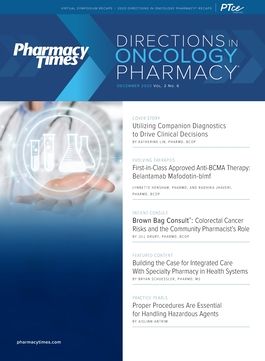Publication
Article
Pharmacy Practice in Focus: Oncology
Peer Exchange: The Diagnosis, Treatment, and Standard of Care for Immune Thrombocytopenia
Author(s):
Key Takeaways
- ITP diagnosis relies on medical history and physical exams, with low platelet counts affecting patient quality of life and treatment complexity.
- Anticoagulants in ITP patients require caution due to thrombotic risks, especially with comorbidities like lupus or Evans syndrome.
Experts say the COVID-19 pandemic may create a shortage of plasma therapy.
Medical history and a physical exam remain care providers’ best tools when diagnosing cases of immune thrombocytopenia (ITP); however, challenges remain.
In a recent episode of the Pharmacy Times® Peer Exchange live event series, experts discussed challenges in diagnosing, treating, and managing ITP, and current standards of care. The discussion was moderated by Bhavesh Shah, RPh, BCOP, senior director of specialty and hematology/oncology pharmacy, Boston Medical Center Health System, Boston, Massachusetts.
Ali McBride, PharmD, MS, BCOP, FASHP, FAzPA, clinical coordinator of hematology/ oncology, University of Arizona Cancer Center, and clinical assistant professor, University of Arizona College of Pharmacy, both in Tucson, Arizona, said that because ITP is a blood disorder characterized by decreased platelets, the condition doesn’t just affect the patient, but also daily living.
“When we’re looking at a patient’s normal platelets level, we’re looking at 400, 500, depending on our patients. Since we work in oncology, our bias is 100 at baseline, where everyone else is at around 400. So, these are distinguishing factors when we take a look at a normal baseline platelet count. But in the ITP situation, this is clearly a different setting. For ITP, these patients often have low-level platelets, 25, 15, 10s,” McBride said. “It’s not uncommon ... albeit rare, where we see patients with 5, 3s, or 2s, when we don’t see those patients on treatment, or they’re [on] refractory treatment as well.”
According to McBride, most older patients come to a hematologist with a referral from a primary care physician. Often, patients will present with petechiae like those caused by warfarin. Once the primary care provider sees that the patient is not on warfarin and has a low blood count, the patient is referred to a specialist in benign hematology.
According to David Hughes, PharmD, BCOP, clinical pharmacy specialist in hematology/ oncology at Boston Medical Center/Boston University School of Medicine, anticoagulants and ITP can be a risky mixture. Many patients with ITP also have comorbidities and underlying health conditions, making diagnosis and treatment more complicated.
“So, for example, something like lupus or Evans syndrome or syndromes that make patients that are more of a thrombotic state, they’re ultimately put on anticoagulation. And these patients can still experience venous thromboembolisms or clots, even when their platelets are below the normal limit of normal. So, I think a lot of this comes when we do end up anticoagulating a patient, it’s to be done with extreme caution,” Hughes said.
In treating patients with ITP, treatment should focus on improving quality of life, not just raising platelet counts. Hughes said a person’s physical activity and environment may need to be considered. Frequent clinic visits, ongoing monitoring, and hospitalizations are to be expected, but will also affect quality of life.
“You have to be more cognizant of some of the things you’re out and about doing. A typical nose-bleed that someone may have in allergy season may be something that may be more detrimental to a patient with ITP,” Hughes said.
When it comes to ITP, steroids are the normal course of treatment, according to experts. When deciding on treatment, a patient’s comorbidities, activity levels, and lifestyle all should be considered. Intravenous immunoglobulin (IVIG) treat- ments have become a mainstay of ITP treatment, because they slow the destruction of platelets.
However, distance issues and the coronavirus disease 2019 (COVID-19) pandemic can make access to IVIG treatment difficult.
“And for many of our patients these days ... some of the [issues involve] things that you can ingest, which can cause low platelets, but also how far [away] they live. This is a big issue. For us, we have people coming [from] 4 hours away.... But essentially, looking at this, we do have to address those monitoring pieces,” McBride said.
The COVID-19 pandemic may also cause a shortage of plasma, which is being used to treat the virus. This may affect ITP patients. According to Hughes, patients may not be able to remain on IVIG, and will move to steroids.
“But after stimulating platelets, you’re at a point where you’re running out of treatment lines in that relapsed setting, and at some point, these patients may become refractory to all available options. There’s not this large armamentarium of drugs that we have at our disposal for ITP. We have targeting production or destruction by using steroids. But after that, I think we’re definitely at an unmet need where we need more therapies,” Hughes said.
For the treatment of relapsed or refractory ITP, oral therapies can prove invaluable. Oral therapies mean the patient does not have to come to the clinic all the time, but lab follow-ups remain available. TPOs and spleen tyrosine kinase (SYK) inhibitors have proven useful in ITP treatment, and the transition to them has been seamless, according to McBride.
“So the utilization of an oral therapy where they can actually have labs followed up, they don’t need to come in all the time, the advent, as we’ve talked about many times, of telemedicine really has allowed for remote monitoring of patients while they’re on therapy, especially oral therapies,” McBride said.







